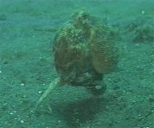
« PREVIOUS ENTRY
Rental justice
NEXT ENTRY »
How to fake an ATM

It wouldn’t feel like a genuine re-launch of this blog without fresh news of our cephalopod overlords. That’s why I was so pleased to hear of the recent discovery that some tropical octopi have learned to wrap six of their legs around their heads — and walk on the remaining two, upright like humans. Check out the video here: It is, as UC Berkeley grad student Crissy Huffard excitedly reports, the first-ever example of “hydrostatic bipedal movement”. If these things ever develop opposable thumbs we are, clearly, screwed.
I had sort of hoped the octopi had decided to walk on two legs just because they thought it would totally rock. But it appears to be a defense mechanism, as one of the investigators notes:
Huffard and coauthor Robert Full, professor of integrative biology at UC Berkeley, think that this bipedal walking is a strategy octopuses use to backpedal away from predators while remaining camouflaged. Octopuses camouflage themselves by changing both color and shape, but when startled and forced to move quickly, they have to give up their camouflage.
Not so when walking.
“This bipedal behavior allows them to get away and remain cryptic,” said Huffard.
(Thanks to Plastic for this one!)
I'm Clive Thompson, the author of Smarter Than You Think: How Technology is Changing Our Minds for the Better (Penguin Press). You can order the book now at Amazon, Barnes and Noble, Powells, Indiebound, or through your local bookstore! I'm also a contributing writer for the New York Times Magazine and a columnist for Wired magazine. Email is here or ping me via the antiquated form of AOL IM (pomeranian99).

ECHO
Erik Weissengruber
Vespaboy
Terri Senft
Tom Igoe
El Rey Del Art
Morgan Noel
Maura Johnston
Cori Eckert
Heather Gold
Andrew Hearst
Chris Allbritton
Bret Dawson
Michele Tepper
Sharyn November
Gail Jaitin
Barnaby Marshall
Frankly, I'd Rather Not
The Shifted Librarian
Ryan Bigge
Nick Denton
Howard Sherman's Nuggets
Serial Deviant
Ellen McDermott
Jeff Liu
Marc Kelsey
Chris Shieh
Iron Monkey
Diversions
Rob Toole
Donut Rock City
Ross Judson
Idle Words
J-Walk Blog
The Antic Muse
Tribblescape
Little Things
Jeff Heer
Abstract Dynamics
Snark Market
Plastic Bag
Sensory Impact
Incoming Signals
MemeFirst
MemoryCard
Majikthise
Ludonauts
Boing Boing
Slashdot
Atrios
Smart Mobs
Plastic
Ludology.org
The Feature
Gizmodo
game girl
Mindjack
Techdirt Wireless News
Corante Gaming blog
Corante Social Software blog
ECHO
SciTech Daily
Arts and Letters Daily
Textually.org
BlogPulse
Robots.net
Alan Reiter's Wireless Data Weblog
Brad DeLong
Viral Marketing Blog
Gameblogs
Slashdot Games